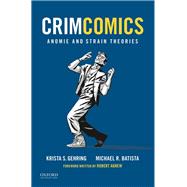CrimComics Issue 5 Anomie and Strain Theories

CrimComics Issue 5 Anomie and Strain Theories
- ISBN 13:
9780190207182
- ISBN 10:
0190207183
- Format: Paperback
- Copyright: 04/17/2018
- Publisher: Oxford University Press
List Price $15.99 Save
| TERM | PRICE | DUE |
|---|---|---|



List Price $15.99 Save $6.25
In Stock Usually Ships in 24 Hours.
We Buy This Book Back!
Free Shipping On Every Order
List Price $15.99 Save $0.16
Usually Ships in 3-5 Business Days
We Buy This Book Back!
Free Shipping On Every Order
Note: Supplemental materials are not guaranteed with Rental or Used book purchases.
Extend or Purchase Your Rental at Any Time
Need to keep your rental past your due date? At any time before your due date you can extend or purchase your rental through your account.
Summary
Issue 5, Anomie and Strain Theories, introduces students to Robert Merton's Anomie Theory, which posits that the idea of the American dream is implicated in the social production of crime. It also discusses two extensions of his theory, General Strain Theory and Institutional-Anomie Theory. Other issues include Issue 1: Origins of Criminology, Issue 2: Biology and Criminality, Issue 3: Classical and Neoclassical Criminology, and Issue 4, Social Disorganization Theory.






